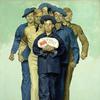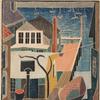The Morgan Provides a Rare Chance to See John Singer Sargent’s Overlooked Charcoal Portraits
- NEW YORK, New York
- /
- September 19, 2019
John Singer Sargent (1856–1925) was one of the greatest portrait artists of his time. While he is best known for his powerful paintings, he largely ceased painting portraits in 1907 and turned instead to charcoal drawings to satisfy portrait commissions. These drawn portraits represent a substantial, yet often overlooked, part of his practice, and demonstrate the same sense of immediacy, psychological insight, and mastery of chiaroscuro that animate Sargent’s sitters on canvas. The Morgan Library & Museum in New York will present the first major exhibition to explore these expressive portraits in charcoal, John Singer Sargent: Portraits in Charcoal, on view from October 4, 2019, through January 12, 2020.
Recognizing the sheer scale of Sargent’s achievement as a portrait draftsman, this exhibition comprises over fifty drawings, including important international loans, from both public and private collections. The drawings showcase Sargent’s sitters, many of them famous for their roles in politics, society, and the arts. Sargent’s charcoal portraits are remarkable not only for
their quantity—they number over 750 in total—but also for their vivid portrayal of the men and women who sat for him. The portraits become telling records of artistic and cultural friendships, as well as the networks of patronage that underpinned Sargent’s practice as a portrait draftsman in Edwardian Britain and Progressive Era America. These writers, actors, politicians,
musicians, artists, patrons, and friends shaped not only Sargent’s life, but also the social and cultural fabric of the United States and Great Britain in the early twentieth century.
Important portraits in the exhibition include a drawing of Sybil Sassoon, a leading light of London society and a close friend of the artist. Sargent had known Sassoon since she was a girl, and his sensitive drawing portrays her on the threshold of
adulthood. Another of Sargent’s sitters and closest friends included in the exhibition is the author Henry James. James had championed the young Sargent’s work, and the two Americans moved in the same transatlantic intellectual and cultural circles. Sargent also sought out sitters who interested him and offered to make their portraits, as with his drawing of Ethel Barrymore.
Sargent’s striking charcoal captures the soulful eyes and commanding stage presence for which the American actress was known.
By the time Sargent switched his portraiture practice almost entirely to charcoal, he had developed a consistent format for his portrait drawings. Before he set to work, Sargent seemed to have a clear image in his mind of what he wanted to achieve. He focused on the head and shoulders of each sitter, depicting them a little less than life-size. After establishing key proportions and masses, he would develop the drawing in stages, elaborating details at the end.
Often set against a dramatic dark background, these subjects have a powerful presence. Many sitters recounted the speed and confidence with which Sargent worked; he finished most of these charcoals in less than three hours. The artist would often invite friends to drawing sessions to keep the sitters entertained and also to help enliven their features. The finished charcoal portraits are valuable testaments to Sargent’s prodigious skill as an artist and draftsman.
Sargent had little interest in promoting his career as a portrait draftsman, and these charcoal drawings were rarely exhibited. While many of the portraits were commissions, a number were gifts from the artist to his sitters, tokens of Sargent’s admiration and affection for talented performers and valued friends. The portraits often remained in the private collections of the sitters and their descendants. This exhibition is the first in recent times to assemble such a wide selection of Sargent’s drawn portraits, and many of the works have never been publicly exhibited before.
John Singer Sargent: Portraits in Charcoal was conceived by Richard Ormond, a renowned Sargent scholar and the artist’s grand-nephew. The exhibition was developed in partnership between the Morgan Library & Museum and the Smithsonian Institution’s National Portrait Gallery. The Morgan’s presentation is curated by Laurel Peterson, Moore Curatorial Fellow in
the Department of Drawings and Prints. Following the New York debut, the exhibition will travel on to Washington, D.C., where it will be on view at the National Portrait Gallery from February 28 through May 31, 2020. The presentation at the National Portrait Gallery will be organized by Robyn Asleson, Curator of Prints and Drawings.
“John Singer Sargent: Portraits in Charcoal is a long overdue celebration of Sargent’s achievements as a portrait draftsman,” said Colin B. Bailey, Director of the Morgan Library & Museum. “Despite numerous exhibitions and scholarly publications recognizing the artist’s oil portraits, watercolors, landscapes, figure studies, and mural paintings, Sargent’s charcoal
portraits have been largely overlooked in the more than ninety years since his death. Yet they are valuable testaments to his skill in sensitively capturing the essence of his subjects.”
“It seems particularly appropriate that this enchanting exhibition is taking place at the Morgan Library,” said Chris McInerney, President and CEO of the Jerome L. Greene Foundation. “John Singer Sargent was making portraits when Pierpont Morgan was amassing his collection, and now, a century later, the Library is presenting new ways of appreciating Sargent’s oeuvre. We are pleased to once again partner with the Morgan Library.”
Accompanying the exhibition is a catalogue published in association with D Giles Limited, which presents over fifty superb portrait drawings. The catalogue features sitters famous for their roles in politics, society, and the arts, including W. B. Yeats, Gertrude Vanderbilt Whitney, Winston Churchill, Ethel Barrymore, and Elizabeth, the Queen Mother. An introduction and catalogue entries by Richard Ormond explore Sargent’s artistic process and highlight the relationships that influenced Sargent during a period of rich Anglo-American cultural exchange. The volume also includes a foreword by Colin B. Bailey, Director of the Morgan Library & Museum, and Kim Sajet, Director of the National Portrait Gallery, Smithsonian Institution.
















